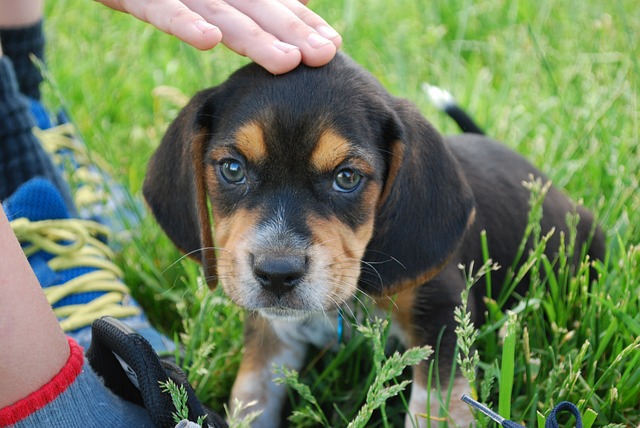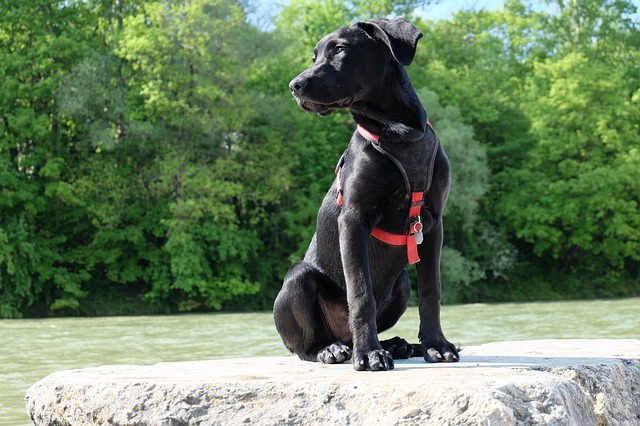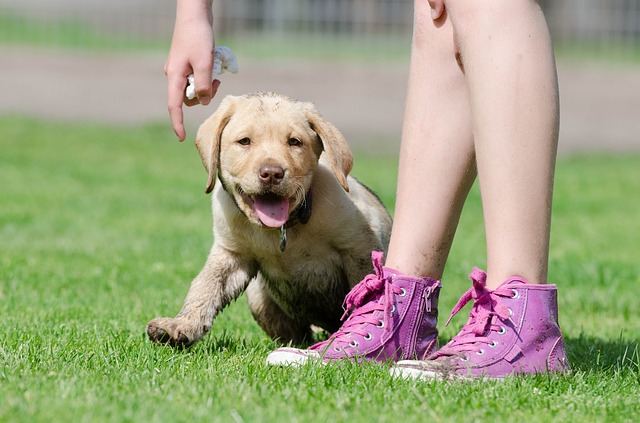With their satiny soft ears, perfectly plump paw pads, and irresistible puppy dog eyes, falling in love with your new puppy is easy. What you teach your new puppy, however, is a different story.
Countless cute puppies grow up to be adult dogs with unmanageable behavior problems, and animal shelters are filled with dogs that were surrendered because no one took the time to train them. If you want your puppy to grow into the adult dog you’ve always wanted, training should be a top priority. Puppies are never too young to learn, and your training sessions should start the day you bring your new family member home.
Here are the first 10 lessons to teach your new puppy to get your relationship started on the right paw.

1. Potty Training
For the sake of your flooring, potty training should be first on the agenda of things to teach your new puppy. You’ll need to consider your living situation and your puppy’s vaccination schedule before getting started, but potty training a dog always depends on the same three steps.
First, show your puppy to their designated potty spot. Say something like, “Go potty,” and reward them when they do their business.
The second thing you’ll need to know is what to do when your pup makes a mistake—which they inevitably will. If you catch your puppy lifting a leg or taking a squat on the carpet, calmly interrupt them and lead them outside to their potty spot. If you don’t catch them in the act and only find the stinky evidence of their crime, there’s unfortunately nothing to do but grab the carpet cleaner. Scolding them after the fact or rubbing their nose in the mess won’t do you any good—in fact, it’ll seriously damage your budding bond.
Finally, keep your expectations in check. It’s generally understood puppies can only “hold it” for as many hours as they are months old. That means your two-month-old pup will need to go to the bathroom every two hours.
Related: 12 Best Probiotics for a Puppy
2. Appropriate Playing
A puppy that play bites can be cute, but the older they get, the worse the problem will be. To set your pup up for success, teach your new puppy appropriate play starting during your first play session. If they play with their teeth or claws, immediately stop playing and say something like, “Ouch!” in a startled tone of voice.
They won’t learn the “no teeth” lesson on the first try, but if you’re consistent, they’ll eventually connect the dots and realize if they bite, the fun is over. Dr. Becker with Mercola Healthy Pets also reminds pet owners that rough punishment is never the answer to training a puppy. She says,
“Whatever you do, don’t try to manage your puppy’s aggressive behavior by acting aggressively yourself. It’s never appropriate or productive to hit or shake a puppy, or grab his muzzle.”
Related: The Best Toys For Puppies To Learn And Play With
3. Focus
Your puppy’s train of thought probably goes something like this, “Oh, look, that hooman is talking to me. That’s a nice hooman, I wonder what—SQUIRREL!” It’s adorable, but it’s not ideal for training. Without first establishing focus, all future training sessions will both start and stop in frustration.
The first lesson to teach your new puppy to focus is the “look at me” game. The rules are simple; when your puppy willingly looks at you, they get a treat. You can wave your hands or click your tongue to get their attention, but don’t touch them. When you first start playing, your puppy only needs to look at you for a second to earn their reward. But as you keep going, make them pay attention to you for longer before doling out the good stuff.
Related: Best Online Dog Training Schools
4. Name Recognition
Some dogs learn their name on their own after weeks, months, or years, but your puppy’s life will be a lot less confusing if you take the time to formally teach them what they’re called. The first lesson to teach your new puppy name recognition is a lot like the “look at me” game. But this time, you want your pup’s name to be their cue to look at you. Only say their name once, and reward them when they look at you.
You should play the simple name game multiple times a day for several days until your pup is reliably responding to their name. From there, you can increase the difficulty by adding distractions and calling their name in unfamiliar environments.

5. Come
Having a good recall is one of the most important skills to teach your new puppy, but it’s also one of the hardest to perfect. Your puppy won’t be a recall rockstar right away, but learning this lesson early could end up saving their life some day in the future.
American Kennel Club teaches pet parents to train the basics of “come” in a quiet, familiar area. They say,
“First move into a squat position with your arms open wide. Say the word “come.” If she [the puppy] starts moving toward you, give her verbal praise. Whatever you do, don’t reach out and grab her as she gets close to you. That will confuse her.”
To make sure your puppy knows you’re in training mode, use her newly earned name recognition skills. Say her name, and then call her to you. Remember to always use the same language, and only say the cue once. If your pup doesn’t come to you, calmly walk over to them, attach a leash, and bring them back to the spot where you called them. Praise and reward them before trying again.
Related: Best Dog Training Treats
6. Sit
If a dog only knows one thing, it’s usually the word “sit.” Puppies as young as eight weeks old can learn this skill, and most pick it up quickly.
First, hold your hand with your palm facing up and put a tasty treat on your fingertips. Make sure your pup doesn’t snatch it from you as you hold it in front of their nose. Once their eyes are locked onto the prize, slowly raise your hand above the puppy’s head and say the word “sit.” As they follow the treat, the natural movement is to sit down. As soon as their fluffy bottom touches the ground, tell them how awesome they are and give them the treat. Keep repeating this movement until you teach your new puppy to sit without having the treat in front of them.

7. Stay
The key to teach your new puppy “stay” is convincing your dog that staying when you say so is more rewarding than whatever else they could be doing. Start by getting your dog to sit still while they’re close to you. Direct them to sit, and then hold your hand with your palm facing them and say “stay” in a firm voice. As long as they stay focused on your hand and don’t move for 20 seconds, give them a reward.
Repeat this process several times before taking a step backward. If your dog moves, guide them back to their original spot and try again. Don’t increase the distance between you and your dog until they’re reliably staying from where you are. As they get better, make them stay for longer periods of time while you get farther away.
8. Heel
Having your arm pulled out of its socket during walks is no fun. Even if your puppy stays small forever, all dogs need to know leash manners. The traditional meaning of the word heel is to have the dog walk close to your left side, but you can pick the side that feels most comfortable.
Your puppy’s first lesson in heeling should happen during your first walk together. Start by positioning them so they’re standing by your side facing forward. Use their favorite squeaky toy or a tasty treat in your opposite hand and hold it out in front of them. As you step forward and say the word “heel,” you want your puppy to follow the prize and step forward with you.
If they get distracted, squeak the toy or call their name. For the first several tries, reward your pup after a few steps. As they get better, try keeping their focus for longer. Once they get the hang of heeling, drop the toy and rely on the verbal cue alone.
Related: The 15 Best Dog Training Books

9. Go To Your Place
When your dog is overenthusiastic about greeting visitors, excited for their impending dinner time, or they’re about to do something mischievous, you’ll wish they knew a “place” command. It’s all about redirecting your dog’s energy toward a learned behavior that keeps them out of trouble and also satisfies their need to do something—even if that something is waiting patiently.
The first thing you’ll need to teach your new puppy “place” is an area that belongs 100% to your dog—a dog bed, mat, or crate are the best options. Your goal is to teach your dog the “place” command so no matter what’s going on around them, they’ll know the best things happen when they’re in their place. To do this trick correctly, your pup will also need to know the cues for “sit” or “down” and “stay.” Best Friends Animal Society suggests introducing the trick this way:
“With the arm that is closest to the mat, toss a treat onto it. As soon as the dog steps onto the mat, use a clicker or say your marker word (e.g., “yes”). Once the dog has eaten the treat, get his attention, say your release word (e.g., “free”) and toss another treat, this time off the mat.”
After several repetitions, try doing it by pointing to the place, and only toss the treat after your puppy is in the right position.
Related: Best Dog Beds
10. How to be Alone
Dogs with separation anxiety howl for hours, destroy furniture, go to the bathroom inside, and hurt themselves trying to escape. It’s a serious behavioral issue, and it’s your job to do everything you can to ensure it doesn’t affect your dog. You’ll be tempted to smother your new puppy with all your love and attention during the first weeks they’re home, but you’ll have to teach your new puppy how to be apart.
Crate training is an excellent way to train a dog to be alone, but whether you crate train or not, the key is to introduce the concept of being alone gradually. Start with five minutes, and if that goes well, increase the time to 10, 15, 30, and then a full 60 minutes. Don’t forget about your pup’s potty schedule, but leaving them during the day is something they need to get used to. The sooner they learn that lesson, the less likely they are to develop separation anxiety.
To ensure you’re helping your dog’s progress rather than hindering it, make sure you aren’t making any of these 5 common new puppy mistakes!

 Toledo, United States.
Toledo, United States.